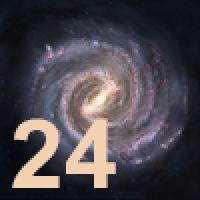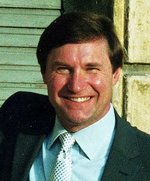
Plus Advent Calendar Door #24: In memory of John D. Barrow
This year we lost our dear boss, friend and mentor, John D. Barrow. Here is what we wrote on the occasion of his death, to share what we learnt from him over the years.
We are very sad to write that the brilliant cosmologist, mathematician and science communicator, John D. Barrow has died. John was Professor of Mathematical Sciences at the University of Cambridge, and the Director of the Millennium Mathematics Project. He had written over 500 research papers and 22 popular science books, given countless engaging lectures for specialists and non-specialists, and even written an award winning play about infinity.

John D. Barrow
We were lucky enough to have John as our boss, and to work next door to him, for many years. It didn't matter what scientific question we had, John was almost certainly able to answer it himself, or remember someone else who could answer it, and hand you their book, their paper, or their contact details. And he was even more pleased if the question gave him the opportunity to work out the problem from scratch on the black board. Not knowing the answer was not something to be worried about, it was an opportunity to learn something new. We wanted to share with you some of the new things John taught us over the years.
Are the constants of nature constant?
There are some numbers you can rely on. The speed of light, c, is 299,792,458 ms-1. The gravitational constant, G, is 6.674 x 10-11 m3kg-1s-2. These are examples of what are often called the constants of nature – fundamental physical quantities that seem to be the same everywhere, and unchanging over time.
Or are they? John used both theoretical exploration and astronomical experiments to investigate this question. "One of the great paradoxes of theoretical physics is that although we can measure the constants of nature to a great degree of accuracy in experiments, we have no idea why they take the values they do." People had hoped to find a theory, a great theory of everything, that would explain why these particular values had arisen. However, as John explained, developments in recent decades, in areas such as string theory, have shown that these constants could take any value. And this provided the motivation for studying whether such constants might be changing in value.
John, together with the astronomer John Webb, initiated an observational programme looking at the light produced by quasars in the distant Universe. They developed new techniques to analyse the light to test if certain constants had the same value near a quasar as they did in laboratories here on Earth. John said: "astronomy provided a better way to test whether the constants were really constant than any laboratory experiment — this is rather surprising!" Cosmologists' ability to turn the Universe into a laboratory has been a great advance in recent physics and a key to new and deeper understanding.
You can find out more about this aspect of John’s work, and how these constants of nature impact on our Universe, in his article and podcast: Are the constants of nature really constant?
We may live in a bubble multiverse
As a cosmologist John was interested in the history and the fate of the Universe. In an interview in 2009, John told us the story of the beginning of the Universe: it began 13.8 million years ago in the Big Bang, when, according to the equations of general relativity, the Universe was infinitely dense and hot. But this, he explained, was a red flag to cosmologists like himself: "A prediction of something infinite is often a sign that the theory you are using to make that prediction has reached the limits of its applicability." This is why cosmologists were exploring ideas that might extend Einstein's theory of gravity to accommodate quantum theory, in order to give a more accurate description of the beginning of the Universe.
John then went on to tell us about one of the more exotic possibilities that had arisen recently – that we are in a bubble multiverse. Most cosmologists believe that our Universe expanded incredibly quickly in just the first few moments after the Big Bang – something called inflation. This inflation theory has survived all the tests that we have set it so far: there is very good agreement between observation and theory. But John told us that some are pushing this idea even further by exploring if this inflation could go on happening. "The early surge of expansion can become self-perpetuating in each piece of the Universe. So a region will surge, and within it there will be another little piece that suddenly surges again. It is like a foam of bubbles where each bubble creates more bubbles that expand too. You should think of each bubble in the foam as being rather like the whole of our visible part of our Universe today."

An inflating bubble multiverse.
You can find out more about this intriguing idea in John's article and podcast where we asked him: what happened before the big bang? Not only does he describe the early Universe, and the possibility we live in a bubble Universe arising from some sort of quantum foam, but he also talks about the philosophical ideas behind testing these cosmological theories.
Staying cool, seeing far, and playing sport
John was a cosmologist, but he was curious about everything and there seemed to be no limit to where his mathematical curiosity would lead him. Over the years we were treated to many office visits where John would share the things that had caught his interest or he thought we might like to know. What connects elephants keeping cool, fish keeping safe and our lungs keeping us alive? (It's surface area.) Just how far can you really see on a clear day? (336km from the top of Mount Everest.) And John, a keen sportsman, shared many, many mathematical insights into the world of sport! There was relativity in rugby, g-forces in gymnastics and running in the wind. But by far our favourite sporting insight was when John mathematically discovered a new rowing rig.
Secrets of the Universe
In a recent interview, John gave a beautiful explanation of the apparent contradiction between the simplicity of the laws of nature and the complex world we live in. John said:
"We [ourselves] are examples of [broken symmetry]. You and I are located at particular positions in the Universe at the moment, but the laws of electromagnetism and gravity which are responsible for us, at some basic level, don't have preferred positions in the Universe. This is one of the secrets of the Universe, if you like. How it can have all these complicated things in it. If the outcomes of the laws had to possess the same symmetries as the laws then there wouldn't be anything in the Universe. It would be a rather boring place."
John – his ideas, his work, his humour and his generosity – definitely made the world a much more interesting place. He taught us so much over the years and we will miss him very much.
John D. Barrow gives a two-minute introduction to symmetry breaking. (This is a clip from a longer interview which you can watch here.)
This year's advent calendar was inspired by our work on the documentary series, Universe Unravelled, which explores the work done by researchers at the Stephen Hawking Centre for Theoretical Cosmology and is available on discovery+. Return to the 2020 Plus Advent Calendar.